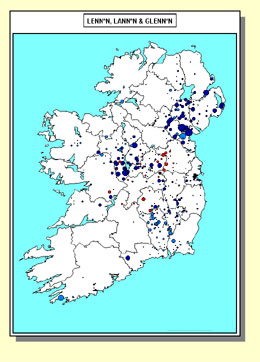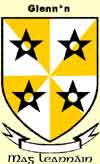
Why Glenn*n not L*nn*n?
Because the project already has 109 participants and a coordinator, enabling L*nn*ns to link in to a mature project with Irish origins with some expectation of links between a quite similar name. In fact one exact match between a Glenn*n and a Lenn*n has already been established with the first Lenn*n participant. Maps are already included on this site for L*nn*n and Glenn*n distributions in Ireland around 1850. A combined plot is illustrated below (click to enlarge, use back button on your browser to return).
Click back button to return to this page.
To begin with, you need to be a male with the (G)Lennon/Lennan/Lannan/Lannon/Lannin/Linnen etc. surname. Brothers or first and second cousins don't both necessarily need to take the test. Your Y-Chromosome and your brother's will be identical (barring extremely unlikely mutations). Ideally there should be two participants from each branch to allow for unrecorded adoptions, etc.. If you are a female, do encourage your male cousins, uncles, fathers, brothers etc. to participate.
It would be very helpful if you have traced your family line back a number of generations. If you can trace them back to Ireland, so much the better, since up to now all participants believe their origins are there! If, however, you know nothing about your ancestors, this study could help you concentrate your research on the right line. However, do not expect Y-DNA analysis to complete your genealogy for you. It will not prove your links. That you must do yourself. But it can open up new avenues.
What are the procedures?
If you are interested, the firm conducting the simple test is Family Tree DNA. Go directly to their website which answers many questions. While the current standard price for the test is $169 for 37 markers (and $268 for the 67 marker test), group discounts can bring this down significantly. Reduced rates are available to participants in the Glenn*n project!
When you have been convinced, which you will be, get in touch with homemyself or the project coordinator Clarke Glennon or go to the Glennon sign up page. If you want complete details of the results within the group you will be asked to agree to share your results within that group and benefit from the results of existing Glenn*n data. For the testing company purposes, signing the waiver you will receive allows them to put you in touch with matches who have also agreed to share information where there is a match. It is suggested you avail of this possibility.
When your test kit comes, simply follow the instruction. Taking the DNA sample is as simple as brushing your teeth, only you just brush the inside of your cheek instead. There is about a 6-week turn-around time once you send off your sample.
When you get your results, you will e-mail Clarke the series of numbers that Family Tree DNA sends you, and he will let you know how you fit in with the existing groups or any new groups that are found.
Other testing possibilities
There are other labs that do Y-chromosome testing, but for the results to be comparable with one another, we need to use FTDNA. The reason for this is that each lab uses different loci to test. Other firms conducting, or who have conducted, similar tests are Oxford Ancestors (but 15 markers), Ancestry previously tested y-DNA, but now concentrates, on broader testing of ethnicity at $99. Like Ancestry, 23andMe, at $199 tests ethnicity as well as health traits . Relative Genetics (a business unit of Sorenson Genomics), and GeneTree (now part of Sorenson Genomics) also conducted yDNA tests for the general public. DNA Heritage in the past provided 23 and 43 marker testing and had perhaps the most informative website of the testing companies (but it has now been taken over by FTDNA). Up to summer 2006 it had the highest resolution yDNA test until the 67 marker test was introduced by FTDNA. Ethnoancestry was renowned for its deep ancestry testing. It was the first firm to market a test for M222, the distinguishing test for the specific 'O'Neill' (Niall of the Nine Hostages) haplogroup. Testing, however, is not cheap. A German firm DNA-Fingerprint provided specific tests on many individual markers, but quite some time ago, joined up with FTDNA. Much more recently a new German company YSEQ, which uses the DNA-Fingerprint laboratory in Berlin, is offering broad yDNA tests (16 markers for $58 and 30 markers at $85). While a lot cheaper than FTDNA, there is no large database of results or surname projects. Of special interest however are their individual marker tests for deep ancestry (SNPs). And, if you are really an expert, they will design primers to test an SNP.
Of interest also is the Genographic Project (NGP) run by National Geographic. The objective of this five-year study is 'to understand the human journey — where we came from and how we got to where we live today'. Scientists are visiting Earth's remote regions in a comprehensive effort to complete the planet's genetic atlas. But in addition the project invites other participants to add data to help to delineate the common genetic tree. Participants submit their DNA for testing which is carried out by FTDNA (on 12 markers for yDNA). Participants can transfer their data to FTDNA projects. If they choose to upgrade the test taken, their sample will be kept after the end of the NGP (and not destroyed at that point) so that other tests can be conducted in the future. FTDNA members can also transfer their genetic information for a small fee (which goes to help finance legacy projects in less developed countries) to the NGP. The NGP website has impressive tutorials giving a genetic overview and an atlas of the human journey. The site is well worth a visit.
One should be careful in the analysis of competing offers to distinguish between firms providing continuing information on matches and those charging a fee per annum for this service. Also some companies will charge for storing data for subsequent testing of newly discovered locii, while others do not store samples. Choice will, however, be mainly conditioned by which firm is doing the most relevant surname project for your needs. For the moment, the big combines on the block for yDNA genealogical testing are, essentially, FTDNA, 23andMe and Ancestry.
Recent or deep ancestry?
Most of the tests noted above are designed for relatively recent ancestry. They test the so-called STRs (Short Tandem Repeats) which change more frequently than SNPs (Single Nucleotide Polymorphism). SNPs (i.e. African, SE Asian, Eurasian etc.) are tested to determine very deep ancestry (haplogroups) but these can usually be inferred from STR results. Most Lennons/Glennons will belong to the Atlantic Modal Haplotype (i.e. the Western European seaboard from Spain up). For the sub-results of the R1b haplotypes of particular interest in this context is the discovery of the North West Ireland version (the so-called 'O'Neill' haplogroup R1b1c7 (now R-M222) which emerged in the 'Irish Clans' study. Results for individual clans surnames can be found in an annex to the TCD academic study 'A y-chromosome signature of hegemony in Gaelic Ireland'. A specifically Southern Irish haplotype was also suggested some time ago. It has now been identified and is classified as R-L21 4466 South Irish. See also where a Munster l (defined by SNP L362) is also identified. A South-West Ireland variety, currently described as Irish Type III (now R-L226), is studied there and elsewhere. Similarly there was a suggested Leinster (or Irish Sea) group but the site is now gone. However it is included in Mike Walsh's overview of some key subclades half way down the page as R-Z255. Another emerging group, but more cross country in coverage, is R1b-CTS3386 of which I am a member. For an overview of some of the literature on Irish origins see here.
Information sources?
If you want to delve further into the science and practice of Y-DNA analysis, peruse the archives of the Rootsweb-DNA-List (change the last two numbers on URL for other months). In my view the most rigorous study is on the surname Pomeroy. Other wide studies are on Graves, with many results in a .pdf file. A simple, but rigorous, explanation of Y-DNA science in general is to be found on the Blair genealogy pages. Of particular interest in Lenn*n terms was (now disappeared) the Maguire project (since original Irish Lenn*ns roots may have been in Fermanagh - for information on L*nn*n/Lunny links). A vague possibility are links to the Laymon/Lemon/Lehman/Layman/Lyman project. The original public database of ydna results, ybase.org has died, and has been replaced by the newer kid on the block, Y-search which has the support of FTDNA. The plug was pulled some time ago on another early database, sgmf.org, supported by Sorenson.
Early results and future interests?
Early overall y-DNA project results would suggest at least three (G)l*nn*n separate branches (for illustration purposes called West, East and Cork). However, common ancestry of some members placed in each group is far from assured, since the rough borderline taken was based on not more than a 10 step difference in markers from the typical haplotype of the group. More than 3 differences is normally considered as taking any relationship back to the pre-surnames era.
Click back button to return to this page.
Check out the map of Lenn*n origins in Ireland page to see the potential groups we would like to document. We think we have some firm Lenn*n data for the Eastern seaboard and we feel that the Roscommon/Galway Glenn*n data could match with Lenn*n data from the same area. We would particularly like to have L*nn*n samples from Armagh/Down/Louth, Monaghan and Kilkenny/Carlow/Kildare/Wicklow. It is thought that this would enable us to positively identify individual L*nn*n branches.
Please e-mail me if you have any questions. My e-mail address is here

 Return to Lennan index page or
advance to Links page
Return to Lennan index page or
advance to Links page![]()
 Or to
data for the index to Lenn*n
entries.
Or to
data for the index to Lenn*n
entries. 
![]() Alternatively, go to my
railwayana.com pages
for Irish railway data
Alternatively, go to my
railwayana.com pages
for Irish railway data ![]()
 Or even, go to my railwayana auction price pages
Or even, go to my railwayana auction price pages 